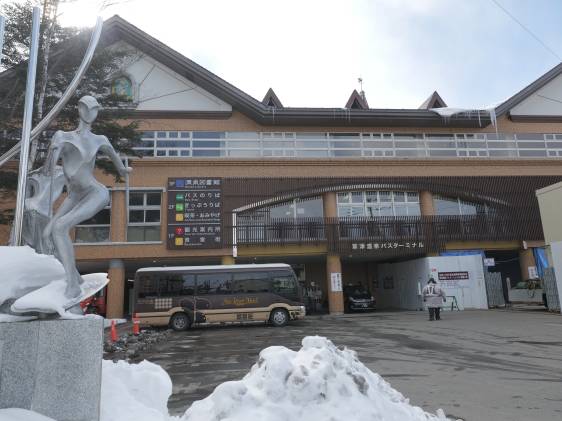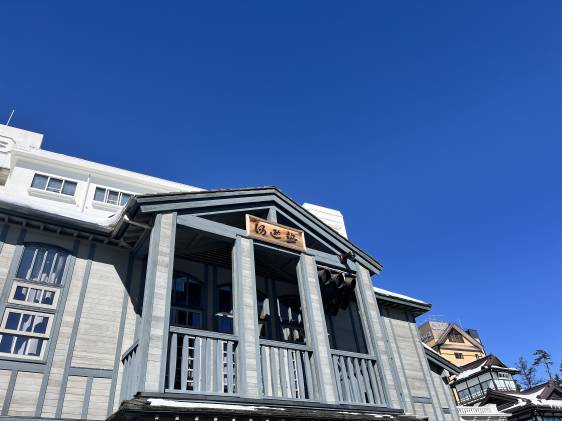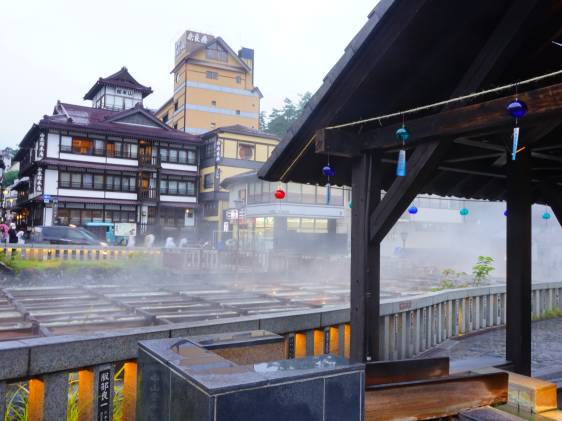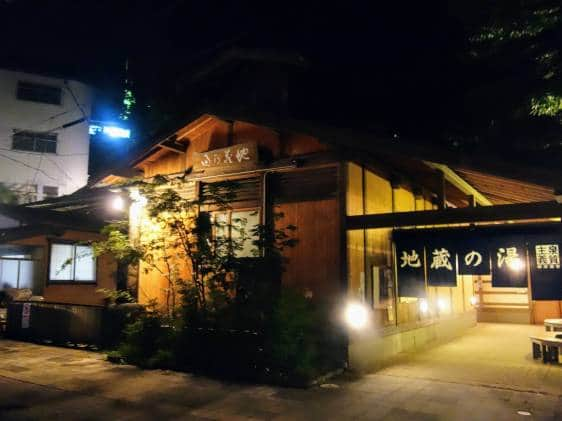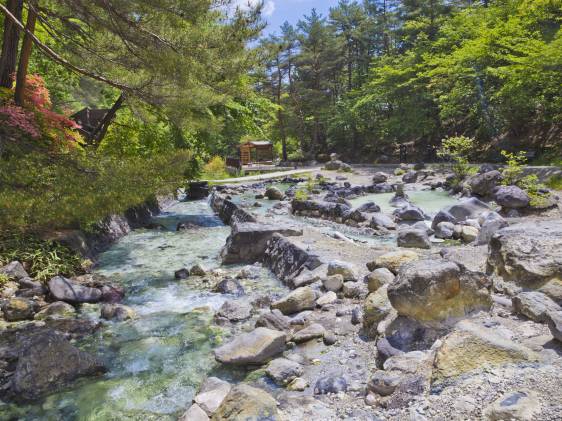How far can 10,000 yen take you beyond the borders of Tokyo? The Cheapo Weekend Escape Challenge is a series of posts about solo overnight trips from Tokyo that cost just one man-note (plus ¥20 in this case!).

Kusatsu is a well-known onsen town that might seem out of reach if you’re on a budget, but with a bit of stretching, you can make it happen. Up in the mountains of Gunma Prefecture, Kusatsu is home to huge amounts of very hot water—and has had to get creative when it comes to ways of cooling it down. With one of the most magical sights in Japan, some beautiful traditions and plenty to test yourself with, this break will leave you relaxed and ready to take on the world.
Pro tip: Read our full guide to an overnight Kusatsu trip by bus.
While it could be a day trip, the final buses leave too early to see the town in its full nighttime glory, so a stay is needed. The water here, aside from being very hot, is high in sulfur, meaning it has a very egg-y smell, but you get used to it. Especially good for the skin, the water is meant to cure every sickness but that of the heart, so dive in and have your achy backs and crick-y knees cured and your worries washed away!
To make this work within the 10,000 yen budget, there are a few things to help keep costs down:
Things to remember:
- A small towel: will save on towel rental at each onsen and essential at public baths that don’t provide them.
- A water bottle: hydration is key when you’re enjoying the onsen, so bring a refillable one as you can also save money.
- A lunch box: You’ll be making lunch for the second day, so it helps to have something to carry it in.
And with that you’re all ready to escape the city and enjoy the sights, smells and soaking opportunities of Kusatsu!
Travel: JR Bus
Saving ¥1,000 compared to trains, the bus is the best way to get to reach Kusatsu and is actually really convenient. JR buses run from Shinjuku Station Bus Terminal and you can book them online or in person. You do need a credit/debit card for online payment (no convenience store options unfortunately) but it is a pretty simple process. The website is in English, just be sure to select your bus stop (Kusatsu Bus Terminal) from the drop-down list after initially selecting Gunma, as it auto-selects an earlier stop—learn from my mistakes. The best part is that you can cancel for a refund (with a 20% charge) up to two hours before the bus departs, so any changes in plans can be accommodated easily. The buses begin from 8:05am and run hourly, arriving in Kusatsu 4 hours later. The ¥3,000 tickets are limited though and usually only available from 11:05am on wards, so for this budget trip, that’s when we’ll be leaving! The regular tickets are ¥3,500 so if you’re feeling flush you can be more flexible with your timing too.
For your return journey we suggest you catch the second to last bus, leaving at 4pm (on the second day) so that just in case you miss it, there’s a back-up (but that’s the dad in me talking). The final bus of the day leaves at 5:30pm and arrives back just after 9:30pm—however, Tokyo evening traffic is bad, so be prepared to arrive late and keep this in mind if you have somewhere important to be that evening.
Total: 6,000 yen (round-trip
Accommodation: Kotodama Guest House
When you arrive in Kusatsu you can head straight from the bus station to your hostel, as it’s only a few minutes away, to dump luggage and check in. Kotodama is simple and traditional, with bunk beds in tatami rooms for up to four people. There is a bathroom and toilet downstairs, as well as a kitchen with everything you need and wifi throughout the property.

Since your night will only cost you ¥2,000, it is to be expected that there are a few frills missing, for example no towels (rental available) but some perks like free laundry and very comfy beds. The host is really friendly, so although the curfew is 10pm, if your shoes are missing, the door won’t be locked without you. You pay in cash on arrival, and don’t need to do anything to check out.
Importantly, there is a small but well-stocked supermarket across the road—but this closes at 7pm, so be sure to head there before you go out for the evening.
Total: 2000 yen
Kusatsu – Day 1
So now that the boring-but-vital parts have been taken care of, you are in Kusatsu, and will be welcomed immediately by the sulfuric smell and beautiful sights! Depending on what you preferences are for your trip, (mainly if you want to hike Mt. Shirane) there is a lot of flexibility as to how you see the sights here, with a few time-limited parts to work around. This is a suggested guide and you can find a small suggested itinerary section at the end!
Luckily, Kusatsu has plenty to enjoy for free, which makes sticking to the budget pretty enjoyable, and means you don’t miss out on the main events. It is a bit of a tight squeeze though, and the section that takes the hit this time is food. I am the last person to sacrifice my dinner, but sometimes there is a need—and sometimes a cup noodle will just have to do. Don’t worry though, there are some treats along the way to make up for it!
Exploring the town
After arriving at around 3pm and dropping your stuff off at the guesthouse, head down to the town centre in time for the the afternoon yumomi performances—one of the top experiences in Kusatsu. Yumomi is the traditional water-cooling technique performed by women of the town with large wooden paddles.

The show includes traditional dancing, singing and water cooling as well as offering audience members the chance to try it. It’s a really interesting experience and also includes a video introduction to the town’s onsen history, so it’s a great way to start your trip! There are six performances a day, with three in the morning and three in the afternoon (fitting very nicely with bus arrivals). While it normally costs 600 yen, if you take this voucher with you, it is reduced to 550 yen (every little helps!). You should be in time for the 4pm or 4:30pm performance, and can buy tickets at the desk at the front of the very noticeable Netsunoyu Building.
Entry costs 550 yen, performances are scheduled for 9:30am. 10am and 10:30am, then 3:30pm, 4pm and 4:30pm.
Next, you can see the most famous sight in Gunma: the yubatake. Since the water reaches temperatures of 70 degrees Celsius, when it leaves the source, it has to be cooled before bathers can enjoy it.

Meaning ‘hot water field’, the yubatake is a wooden structure which funnels the water through the town center, allowing steam to evaporate into the cool mountain air before the water plunges into a bright blue pool and is siphoned off to different ryokan and baths in the town. There are foot baths nearby so take a seat and enjoy the chance to relax!
Dinner
Assuming you’ve worked up an appetite with your yumomi efforts and strenuous relaxing, head back to your hostel via the supermarket. Depending on your preferences, you can spend the princely sum of ¥500 on food for dinner and one meal the following day. This is a push, I know, but some pasta, rice and curry or sandwiches can go a long way, believe me. As you are welcome to use the cooking utensils and store food in the fridge at the guest house, making enough for two meals is easy enough and saves you plenty.
After some tough decisions and a tempting browse, head back and cook your dinner. You may also want to take a shower, since the free public baths here don’t have the same washing facilities as paid onsen.
Top tip: Make your bed early, even if you get the room to yourself, the walls are so thin you can count the breaths of next door’s occupants, so they won’t appreciate your late-night rustling.
Yubatake by night
After dinner, take a stroll back down to the town to view the stunning transformation of the yubatake at night. The lighting game in the town is on point, and the steam creates a magical feeling you have to see to believe. This is one of the few places which genuinely lives up to the photos—places sometimes let you down with tactical editing, heavy filter use or downright lies, but not Kusatsu.

It was impossible not to take a great picture, you didn’t even have to try. Like a blend of something from Hogwarts and Narnia it’s truly beautiful and completely impossible to walk past without stopping and gazing like a moth trapped by the light, every single time.

This adds considerable time to your day, but no complaints here. If you have any spare change from the supermarket, treat yourself to a chu-hai/ice lolly and soak your feet. When you’re done staring, you can try the water yourself!
Onsen time!
There are a number of free onsen in the town, and it soon becomes clear why. We started at Shirohatanoyu (open 5am – 11pm), right by the top of the yubatake. Due to the heat, the bathing tradition here is to have the hot water poured over your head and then to sit in it for just three minutes. Sounds easy, you say. How hot can it be, you say, casual in your naivete. Hot, is the answer, horrifyingly, skin-peelingly hot. Especially when you stick your legs in like the 90-year-old Japanese lady did before you as if it were a gently warmed swimming pool rather than a bath of actual lava.

I may be exaggerating, I may not. Honestly, it was very hot—and the screams of the schoolboys we heard through walls confirmed this (mainly screams of “Muri!”—“Impossible!”—with which we agreed). You can slowly acclimatize to it, and some may be better than others, but after 15 minutes of trying a quick dip and jumping back out was the best we could manage.

After recovering a little, take a stroll past the glorious yubatake again and down to Jizonoyu (open 8am – 10pm), another public bath that is somehow slightly more manageable. More modern but still without facilities, this bath house is quieter, allowing time to get used to the water again without feeling rushed. We managed full immersion for at least a minute or two here, and your skin does feel great afterwards.
No doubt tired from the slight trauma, you can stroll back through the town and off to a good night’s sleep at your guesthouse, hopefully reaching them before the 10pm curfew (enjoy counting the breaths).
Total day 1 cost: 6,050 for bus, hostel, yumome performance and supermarket
Day 2
So, for Day 2 there are two options: one for hikers and one for the rest of us. Right beside Kusatsu and the source of the heat is Mt. Shirane, a series of volcanic peaks with a stunning blue crater lake. Alternatively, you can enjoy the beautiful park with an open-air onsen and strolling through the town for a very chilled day (or if you have an earlier bus). You can leave your bags at the hostel until later if you would rather, but remember to take your lunch for the day with you!

Whichever option you choose, start your day with a delicious and freshly made bagel from Lucky Bagel, a minute or so from your hostel. They have simple breakfast options including cream cheese and black pepper or you can add honey—all fresh for just ¥250 (I did promise some treats!).
Option 1: Hike Mt. Shirane
Due to volcanic activity, there is a no-entry zone around the crater of Mt. Shirane, which is extended and reduced depending on the risk level. The area was reduced to 500m on July 1st this year, so you can now go all the way to the nearby rest house and viewing point to see the spectacularly blue lake. Hiking from Kusatsu to the top takes approximately 4 hours.

You can hike between mid-April and early November, but the road is closed to everyone (even traffic) for the intervening months. There is a ropeway which takes about 10 minutes and a couple of ski lifts you can catch up to different parts of the trail (but these aren’t in the budget sorry).
If you would really like to see the Yugama Lake, and don’t mind spending more, there is an hourly bus that takes you up to Shirane Resthouse from the bus station and costs around ¥1,200 each way, taking 30 minutes. From the guesthouse, it’s a 10-minute hike up a paved-ish path to the viewpoint. If you do decide to hike up, make sure you have enough back-up cash to get the bus back, in case you are running out of time to catch the coach home.
Option 2: Day in town
If you’re not a hiker (or you caught the bus and still have plenty of time to spare) this is a great chance to explore the town and relax in some more bearable waters. After your bagel, wander up the many steps to Kosenji Temple, a small but pretty temple with small charms for sale, as well as some interesting statues and smaller shrine buildings with thatched roofs.

The specialist charm here is for late bloomers—those who feel they were later than most, and wish to bloom again in the future, are encouraged to pray here.

Next, wander back down to Sainokawara Park to see the beautiful natural surroundings of the town, with hot water bubbling into streams and collecting in brightly colored pools. The park is part of a valley filled with small hot-spring outlets and you can see steam rising from pathways as you explore.

Once you reach the top, you can head into the outdoor rotenburo—one of the most relaxing spots in the city. Whether it’s snowy and cold outside, raining or sunny, this place is stunning. The large gender-separated pools can take up to 100 bathers, but never do, leaving you with plenty of space to stretch out and soak in all the sulfury goodness. The pool costs ¥600 and has a simple rinse system rather than full showers.
Sainokawara Park Rotemburo – Open from 7am – 8pm, from 9am Dec-March (last entry 30 minutes before)
On your way back into town you’ll be walking along the narrow shopping street with stalls and shops filled with souvenirs and snacks. One of the must-tries here is the onsen egg:

Cooked softly in a bubbling pool right in front of you, the eggs are soft and delicious (if you’re not sure, just stick to the yolk, it’s creamy and tastes amazing!)

Just around the corner is an omiyage store selling boxes of fresh onsen manju—the steamed sweet bun filled with red bean paste or matcha.

These are steamed using onsen water and are delicious—soft and sweet, with a slight stickiness. The shopkeepers hand them out freshly baked with bowls of green tea, all for free, so you can try one yourself.

They’re really friendly and were keen to chat, showing us how they make them and later feeding an entire high-school hockey team who were walking past. If you need souvenirs for work, this is an excellent spot with boxes starting at ¥500.
Next, you can find a spot in town and enjoy your lunch by the yubatake, with a foot-bath break afterwards for ultimate relaxing! You can pop up to grab your bags and then head back to Tokyo on the bus—feeling squeaky clean and as chilled as can be.
Total day 2 cost: 3,970 yen for bagel, baths, egg and bus
Cheapo Challenge Results:
So is the budget actually feasible? While it’s easy to go over, you can make it!
| Expense | Day | Details | Cost |
|---|---|---|---|
| Transport | 1 | Bus: Shinjuku – Kusatsu | ¥3,000 |
| Accommodation | 1 | Kotodama Guesthouse | ¥2,000 |
| Sightseeing | 1 | Yumomi Performance | ¥550 |
| Food | 1 | Supermarket Shopping | ¥500 |
| Sightseeing | 1 | Hot Water Public Onsen | Free |
| Food | 2 | Breakfast Bagel | ¥250 |
| Sightseeing | 2 | Hike: Yugama Crater Lake | Free |
| Sightseeing | 2 | Sainokawara Outdoor Pool | ¥600 |
| Food | 2 | Onsen Egg | ¥120 |
| Transport | 2 | Bus: Kusatsu – Shinjuku | ¥3,000 |
| Total: | ¥10,020 |
Also see our weekend escape challenge to Yunessun Spa Resort in Hakone.


